For quite some time I’ve been a proponent of early entry of Basal Eurasian into European hunter-gatherers. This looked a little clearer with the likes of the Iron Gates hunters from Mathieson et al (2018). Not only that, but I was noticing some slight shift from the Gravettians from GoyetQ116-1 (Fu et al, 2016), along with the West Eurasian side of ancient Native Americans, such as the Clovis boy (Rasmussen et al, 2014). While this became much more possible with the discovery and modeling of European hunters with the Dzudzuana pre-print (Lazaridis et al, 2018), I also noticed that another, more ancient Eurasian looked to have a good amount of this deep lineage commonly referred to as Basal Eurasian. This sample was Sunghir IV from Sikora et al (2017).
The Sunghir site is one of the most famous and well-studied sites in Upper Paleolithic Europe. The child burials have been subject of much discussion and even VR reconstruction efforts for their faces have produced interesting results (Holger, 2017).

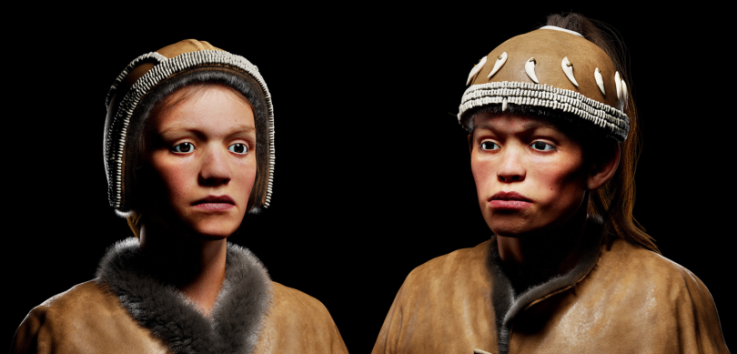
The interesting thing about SunghirIV is that it was a partial femur that was packed with ochre (Sikora et al, 2017). Not only that, the bone chemistry of this individual pointed to a different geographic place of origin for this individual compared to the other Sunghir remains (Sikora et al, 2017).
Looking at D-stats to Form the Base of the Tree
Several things jumped out at me looking at ancient East Eurasians, both Tianyuan (Yang et al, 2017), and Vanuatu_2900BP_all (Lipson et al, 2018), had the same relationship to ancient West Eurasians and to Ust-Ishim (Fu et al, 2014). Not only that, GoyetQ116-1 and MA1 both shared the same relationship with Ust-Ishim and ancient East Eurasians, unlike the other West Eurasian samples. This suggests that at one time, the from at least 36,000 years ago, there may have existed a huge meta-population stretching from Western Europe, all the way to at least Lake Baikal.
| Out | Target | X | Y | D-stat | Z-Score | SNPs |
| Chimp | Tianyuan | GoyetQ116 | MA1 | 0.000116 | 0.132 | 455312 |
| Chimp | Vanuatu | GoyetQ116 | MA1 | 0.000022 | 0.026 | 276242 |
| Out | Target | X | Y | D-stat | Z-Score | SNPs |
| Chimp | Ust_Ishim | GoyetQ116 | MA1 | -0.000697 | -0.864 | 528039 |
Not only that, but Tianyuan must’ve branched off very early from the population that leads to both Vanuatu_2900BP_all and the ENA branch mixing into Native Americans, as Vanuatu is significantly closer to Clovis, but Tianyuan is not significantly closer to Vanuatu than Clovis, despite the latter having significant West Eurasian ancestry.
| Out | Target | X | Y | D-stat | Z-Score | SNPs |
| Chimp | Tianyuan | Vanuatu | Clovis | -0.001261 | -1.9 | 386513 |
Still, in that stretch of nearly 37,000 years, it appears there was no flow from West Eurasians into South East Asians.
The next thing I examined was Ust-Ishim’s place within this phylogeny, as it has been said that he was equally related to modern East Eurasians and ancient West Eurasians. However, a different story emerges when looking at ancient East and West Eurasians together. Ust-Ishim becomes a “Basal West Eurasian”, related to the branch that then mixes with ENA to form the clade shared by Goyet and MA1. While not as significantly set in the West Eurasians as Tianyuan is to East Eurasians, it is still the best fit and may be simply that Tianyuan may have that extra 5,000 years of drift from the population split in Eurasia.
| Out | Target | X | Y | D-stat | Z-Score | SNPs |
| Chimp | Ust_Ishim | GoyetQ116 | Tianyuan | -0.001916 | -2.264 | 624072 |
| Chimp | Ust_Ishim | GoyetQ116 | Vanuatu | -0.001875 | -2.23 | 373102 |
| Chimp | Ust_Ishim | Tianyuan | Vanuatu | 0.000375 | 0.521 | 385677 |
Ust-Ishim being closer to West Eurasians, yet West Eurasians (Goyet and MA1) being much closer to East Eurasians than Ust-Ishim led me believe that admixture from an ENA group to a branch descended from a sister clade to Ust-Ishim was the best fit for MA1 and Goyet.
| Out | Target | X | Y | D-stat | Z-Score | SNPs |
| Chimp | Tianyuan | Ust_Ishim | GoyetQ116 | 0.002363 | 2.787 | 624072 |
| Chimp | Tianyuan | Ust_Ishim | MA1 | 0.002601 | 3.071 | 583856 |
| Chimp | Vanuatu | Ust_Ishim | GoyetQ116 | 0.002612 | 3.261 | 373102 |
| Chimp | Vanuatu | Ust_Ishim | MA1 | 0.002764 | 3.437 | 318634 |
The final piece to the puzzle was to figure out just how SunghirIV fit into this phylogeny. As someone that was not only significantly further from East Eurasians, but also Ust-Ishim, the only thing that seemed to fit this nicely would be Basal Eurasian ancestry.
| Out | Target | X | Y | D-stat | Z-Score | SNPs |
| Chimp | Ust_Ishim | GoyetQ116 | SunghirIV | -0.002626 | -3.37 | 724721 |
| Chimp | Tianyuan | GoyetQ116 | SunghirIV | -0.00331 | -4.132 | 620480 |
The only problem that I knew I would face is the confounding factor of East Eurasians being further from Ust-Ishim than Goyet and most of the ancestry in SunghirIV. Although I can see it as a confirmation of sorts of ancestry deeper than ENA into Sunghir, the worst Z-scores are not going to really reflect this but will probably make SunghirIV an island to himself, or involve ENA pops being closer and another West Eurasian being closer to Ust-Ishim.
| Out | Target | X | Y | D-stat | Z-Score | SNPs |
| Chimp | Ust_Ishim | Tianyuan | SunghirIV | -0.000498 | -0.608 | 803562 |
| Chimp | Ust_Ishim | Vanuatu | SunghirIV | -0.000888 | -1.173 | 430030 |
D-Stats Showing Relationships Between Ancient “West Eurasians”
The D-stats below show the more outlier status of SunghirIV and the more intermediary position of other ancient Europeans and MA1.
| Out | Target | X | Y | D-stat | Z-score | SNPs |
| Chimp | Ust_Ishim | GoyetQ116 | SunghirIV | -0.002626 | -3.37 | 724721 |
| Chimp | Ust_Ishim | GoyetQ116 | SunghirIII | -0.001442 | -1.983 | 670463 |
| Chimp | Ust_Ishim | GoyetQ116 | SunghirII | -0.001702 | -2.339 | 726072 |
| Chimp | Ust_Ishim | GoyetQ116 | SunghirI | -0.001549 | -1.946 | 534517 |
| Chimp | Ust_Ishim | GoyetQ116 | Vestonice16 | -0.001394 | -1.803 | 561487 |
| Chimp | Ust_Ishim | GoyetQ116 | Kostenki14 | -0.001386 | -1.794 | 702161 |
| Chimp | Ust_Ishim | GoyetQ116 | MA1 | -0.000697 | -0.864 | 528039 |
| Chimp | Ust_Ishim | SunghirIV | SunghirIII | 0.001054 | 1.655 | 998961 |
| Chimp | Ust_Ishim | SunghirIV | SunghirII | 0.00094 | 1.444 | 1080491 |
| Chimp | Ust_Ishim | SunghirIV | SunghirI | 0.001261 | 1.897 | 790860 |
| Chimp | Ust_Ishim | SunghirIV | Vestonice16 | 0.001254 | 1.714 | 694500 |
| Chimp | Ust_Ishim | SunghirIV | Kostenki14 | 0.001499 | 2.178 | 1012073 |
| Chimp | Ust_Ishim | SunghirIV | MA1 | 0.002065 | 2.652 | 763784 |
| Chimp | Tianyuan | GoyetQ116 | SunghirIV | -0.00331 | -4.132 | 620480 |
| Chimp | Tianyuan | GoyetQ116 | SunghirIII | -0.001474 | -1.873 | 574387 |
| Chimp | Tianyuan | GoyetQ116 | SunghirII | -0.001893 | -2.351 | 621729 |
| Chimp | Tianyuan | GoyetQ116 | SunghirI | -0.001434 | -1.738 | 458764 |
| Chimp | Tianyuan | GoyetQ116 | Vestonice16 | -0.002817 | -3.472 | 508391 |
| Chimp | Tianyuan | GoyetQ116 | Kostenki14 | -0.003163 | -3.926 | 601682 |
| Chimp | Tianyuan | GoyetQ116 | MA1 | 0.000116 | 0.132 | 455312 |
| Chimp | Tianyuan | SunghirIV | SunghirIII | 0.002014 | 3.032 | 739525 |
| Chimp | Tianyuan | SunghirIV | SunghirII | 0.001629 | 2.332 | 800109 |
| Chimp | Tianyuan | SunghirIV | SunghirI | 0.001864 | 2.606 | 590273 |
| Chimp | Tianyuan | SunghirIV | Vestonice16 | 0.000527 | 0.713 | 607772 |
| Chimp | Tianyuan | SunghirIV | Kostenki14 | 0.000656 | 0.921 | 777500 |
| Chimp | Tianyuan | SunghirIV | MA1 | 0.003533 | 4.299 | 580265 |
Tree Building in qpGraph
The first run here grouped MA1 and GoyetQ116-1 together, since both showed a similar relationship to East Asians and Ust-Ishim. Clovis was grouped with Vanuatu_2900BP_all, since there was significantly more drift shared with this pop, versus Tianyuan. Ust-Ishim was also placed at a position basal to West Eurasians due to the minor shift towards West Eurasians, versus East Eurasians. SunghirIV and the combination of SunghirI, SunghirII, and SunghirIII were placed together due to their closer relationship as well.
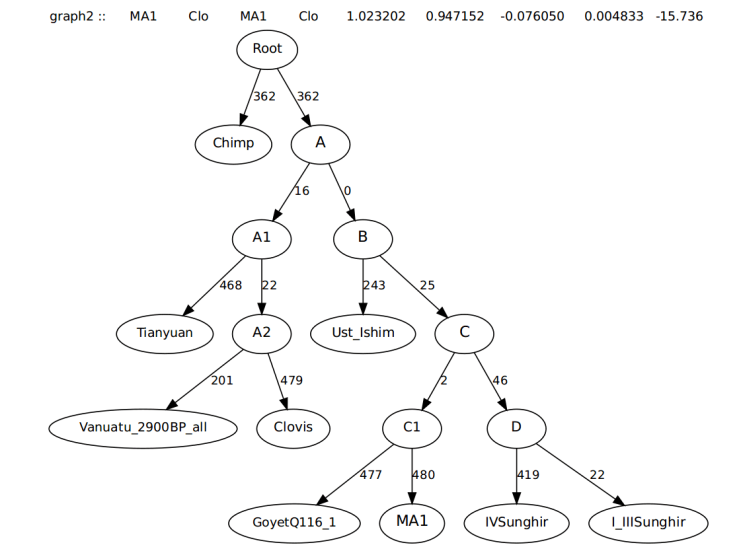
Since the worst Z-score from this run involved flow between Clovis and MA1, the next step was to create admixture from a branch related to MA1 into Clovis.
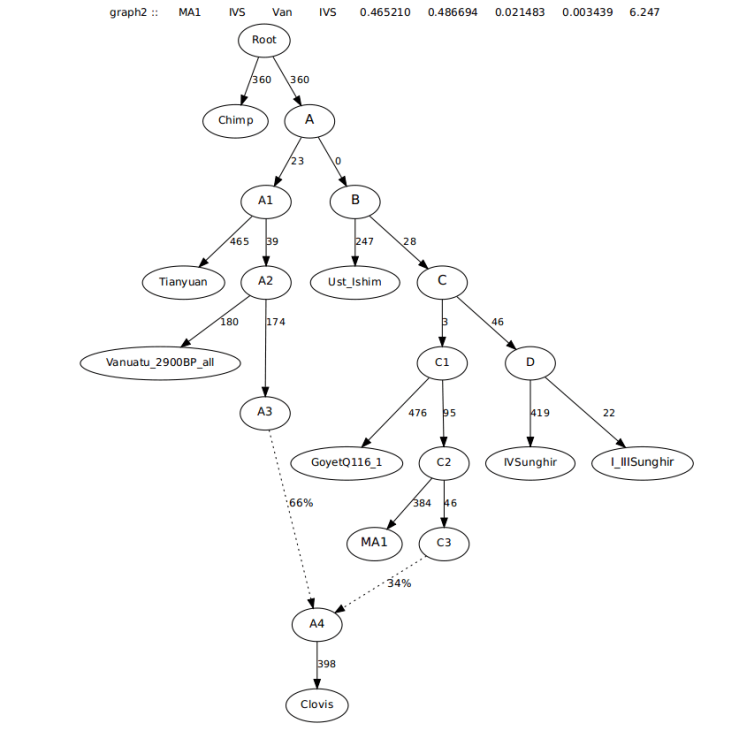
As this graph left a worst Z-score require MA1 to be closer to Vanuatu than SunghirIV, I decided to run an admixture edge from a branch related to Vanuatu into West Eurasians, post-Ust-Ishim, due to Goyet and MA1 being equally related to East Eurasians.
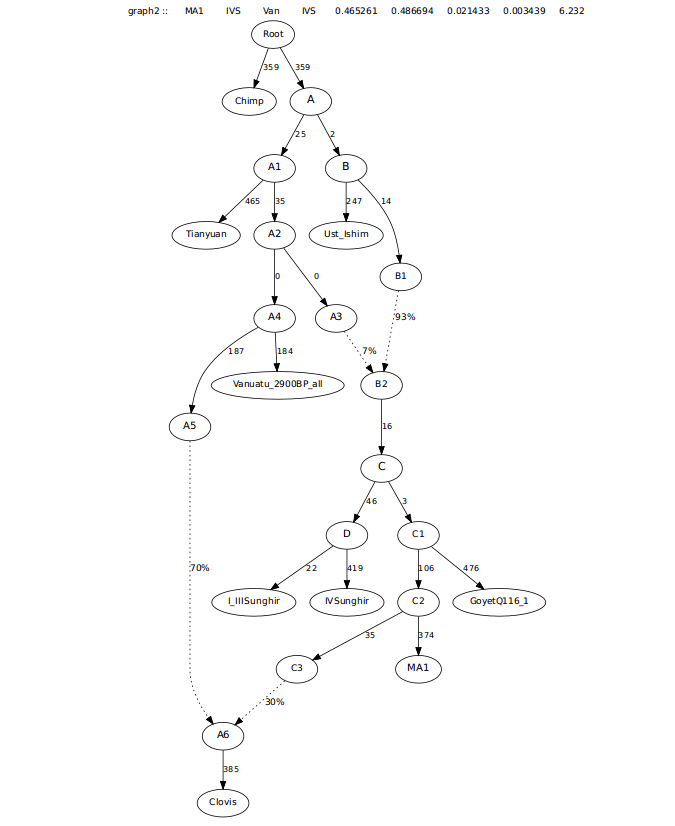
After this admixture edge, there was still a need for MA1 and likely Goyet using D-stats, so I decided to make a “Basal” branch leading into the Sunghir samples.
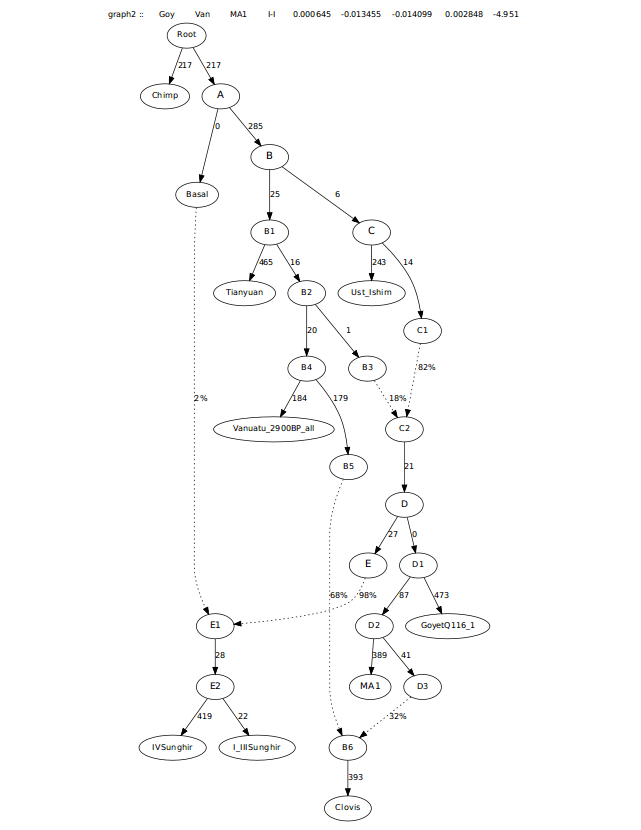
This next run asked for either more admixture from East Asians to MA1 and maybe Goyet, or a closer relationship between Goyet and Sunghir I-III. So, I decided that an extra relationship between Sunghir I-III was more appropriate here since there is no significant relationship between MA1 and Vanuatu compared to the others.
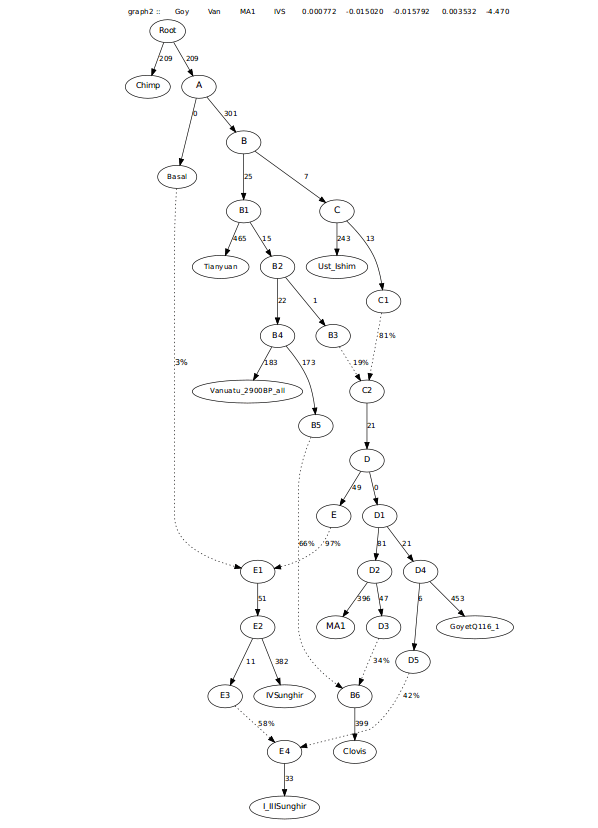
Interestingly, this run left a worst Z-score that asked for a closer relationship to Goyet, for SunghirIV. I interpreted this, along with the 0 drift edge on the branch to Goyet and MA1, that Goyet needed to be moved to a more basal position, relative to SunghirIV.
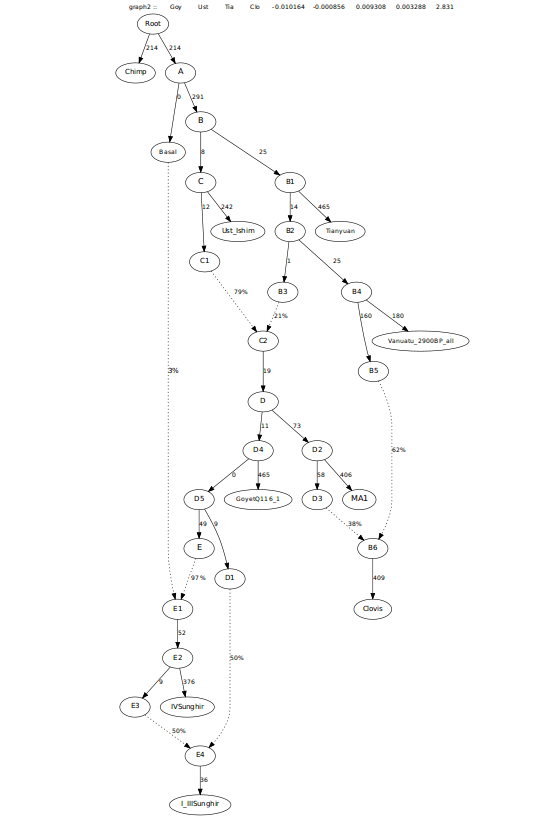
With this last tree, there is a good drop in the worst Z-score, to where the worst Z-score is now below 3. The relationship left may ask for an even more ancient admixture from an Ust-Ishim-related population into the ancestors of Clovis, but for this exercise, I didn’t find it necessary to capture what I was looking for.
Another qpGraph looking at SunghirIV
I took a couple more looks at SunghirIV, compared to Goyet and the other Sunghir samples, this time including Iberomaurusians, and with another one, the Pinarbasi hunter-gatherer. This first tree includes just the Iberomaurusians, where SunghirIV does ask for deeper ancestry, this shared with Iberomaurusians.
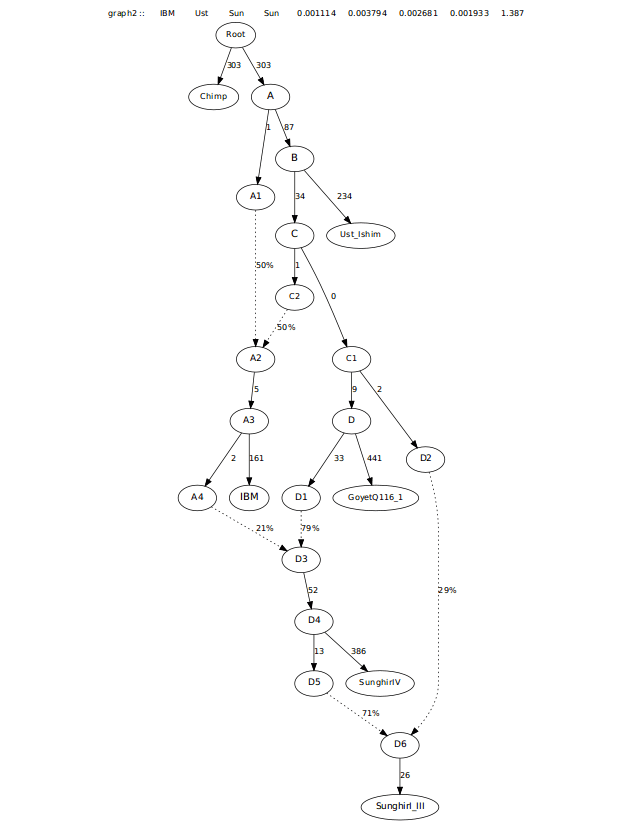
This last graph shows deep “basal ancestry” shared between IBM, Anatolia, and SunghirIV, with SunghirIV being intermediate between Anatolia and Goyet, and SunghirI-III being intermediate with SunghirIV and Goyet. In agreement with D-stats and other trees.
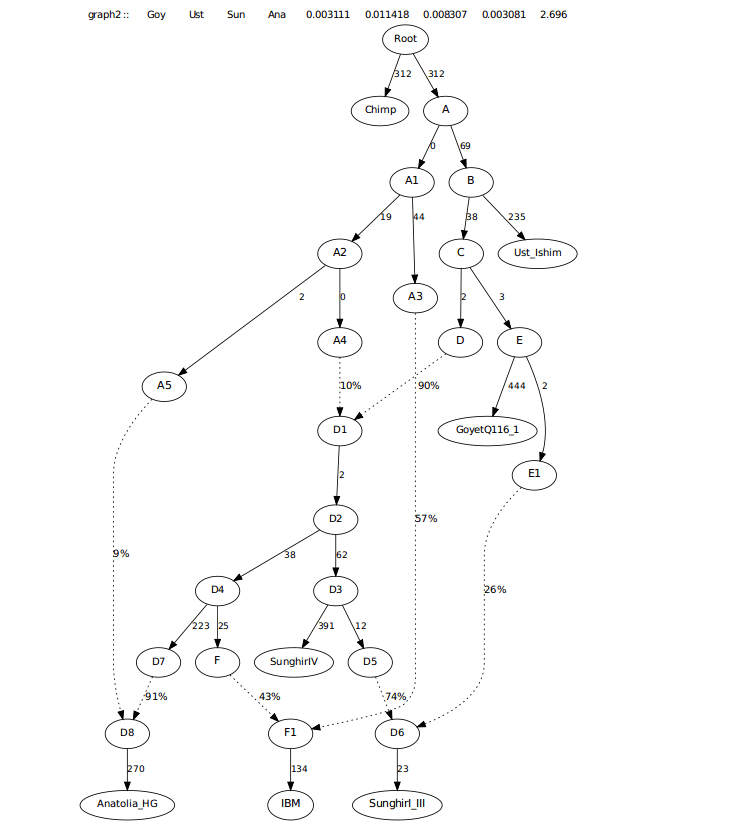
Discussion
While the position of Ust-Ishim and whether or not Asians branch before them does need to be resolved, the position of SunghirIV and the fact that every other West Eurasian is intermediary points to a possible entry of Basal Eurasian to Europe before the time of Dzudzuana. More Aurignacian samples will help to clarify if Goyet is just an outlier, contains some artifact, or is representative of that population. The position of East Asians, relative to Ust-Ishim could be caused by some artifact in the data of ancient East Asians or modern East Asians.
It is also known that mixing modern and ancient samples can also cause issues as there is not only ancient attraction, but potential issues with the mapping, and haploid versus diploid. As ancient samples from East Asia, Europe, and hopefully West Asia come in, this tree may need some tweaking or see some confirmation.
Sources
Fu et al (2014) Genome sequence of a 45,000-year-old modern human from Western Siberia. https://www.nature.com/articles/nature13810
Fu et al (2016) The genetic history of Ice Age Europe. https://www.nature.com/articles/nature17993
Holger (2017) This VR app reconstructs 30,000-year-old homo sapiens faces in 3D. https://vrscout.com/news/vr-app-reconstructs-homo-sapien-faces/
Lipson et al (2018) Population turnover in remove Oceania shortly after initial settlement. https://www.cell.com/current-biology/fulltext/S0960-9822(18)30236-7
Rasmussen et al (2014) The genome of a Late Pleistocene human from a Clovis burial site in Western Montana. https://www.nature.com/articles/nature13025
Sikora et al (2017) Ancient genomes show social and reproductive behavior of Upper Paleolithic foragers. https://www.researchgate.net/publication/320246896_Ancient_genomes_show_social_and_reproductive_behavior_of_early_Upper_Paleolithic_foragers
Yang et al (2017) 40,000-year-old individual from Asia provides insight into early population structure in Eurasia. https://www.cell.com/current-biology/fulltext/S0960-9822(17)31195-8
